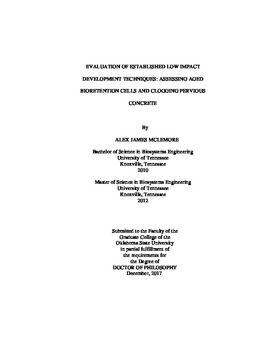| dc.contributor.advisor | Vogel, Jason R. | |
| dc.contributor.author | McLemore, Alex James | |
| dc.date.accessioned | 2018-06-18T16:02:21Z | |
| dc.date.available | 2018-06-18T16:02:21Z | |
| dc.date.issued | 2017-12 | |
| dc.identifier.uri | https://hdl.handle.net/11244/300063 | |
| dc.description.abstract | Low impact development practices are commonly installed to mitigate the negative impacts urbanization can have on stormwater runoff and the environment. Research on the long-term performance of aged low impact development practices is lacking. This dissertation includes three studies related to the long-term performance of aged low impact development practices. The first study focuses on hydraulics and leaching potential of two 8-year old bioretention cells with fly ash media filter media. With the use of flooding tests, it was determined that both bioretention cells were meeting design standards and providing pollution retention. However, both bioretention cells leached bacteria when flooded with treated municipal water. The second study involves the evaluation of pervious concrete infiltration rate changes over time, cleaning methods for restoring clogged pervious concrete, and the correlation of results to pervious concrete mix design. Five different pervious concrete tests plots were evaluated, all were used regularly in a parking lot. Infiltration rate underwent three phases as the pervious concrete aged. There was an initial decrease, then a phase of relatively constant infiltration rates, and finally a secondary decrease after which the pervious concrete was considered clogged. Spraying water while simultaneously vacuuming, significantly (95% confidence level) improved infiltration rates. Mixes with higher sand content experienced improved cleaning. The third study involved the application of porous media x-ray computer tomography (CT) techniques to quantify porosity, clogging, and internal characteristics of aged pervious concrete. Pervious concrete evaluated in the third study was cored from the tests plots in the second study. Void content, clogging, and cementitious material were quantified by adapting a frequency fitting distribution material classification method to x-ray CT images of pervious concrete. This is the first known approach that has classified multiple components within pervious concrete. Clogging material content was greater in the top 10 mm, compared to the rest of the pervious concrete cores. Overall, the LID practices evaluated continued to provide stormwater benefits as they aged. | |
| dc.format | application/pdf | |
| dc.language | en_US | |
| dc.rights | Copyright is held by the author who has granted the Oklahoma State University Library the non-exclusive right to share this material in its institutional repository. Contact Digital Library Services at lib-dls@okstate.edu or 405-744-9161 for the permission policy on the use, reproduction or distribution of this material. | |
| dc.title | Evaluation of established low impact development techniques: Assessing aged bioretention cells and clogging pervious concrete | |
| dc.contributor.committeeMember | Brown, Glenn O. | |
| dc.contributor.committeeMember | Taghvaeian, Saleh | |
| dc.contributor.committeeMember | Holmes, Michael V. | |
| osu.filename | McLemore_okstate_0664D_15442.pdf | |
| osu.accesstype | Open Access | |
| dc.type.genre | Dissertation | |
| dc.type.material | Text | |
| thesis.degree.discipline | Biosystems and Agricultural Engineering | |
| thesis.degree.grantor | Oklahoma State University | |
